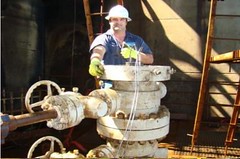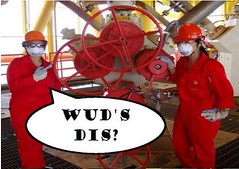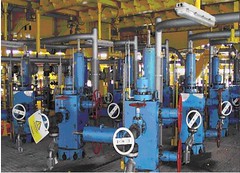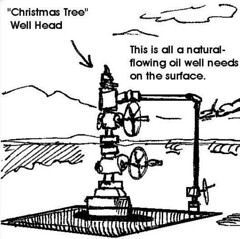Crude futures back below $40 mark in thin trading
NEW YORK (MarketWatch) -- Crude-oil futures fell below $40 a barrel Tuesday, as data showing record-low U.S. consumer confidence as well as plunging housing prices overshadowed concerns about possible Middle East supply disruptions as a result of Israel's air raids in the Gaza Strip. Continue Reading...
Tuesday, December 30, 2008 | 0 Comments
What Do Oil Wells Really Mean?
Oil wells usually refer to a vertical hole drilled in the earth to find and extract petroleum oil and natural gas from the underground layers. Wells are generally composed of a series of small holes and tubing and smaller holes within, encased in cement, whereby perforations along the casing in the production zone enable the oil to flow though rocks into the production casing. Inherent pressure is then enough to allow the oil and gas to flow to the surface. In case the pressure is not enough, other substances may be injected to stimulate it.
Wells can produce three types of products. Some produce only oil. Others produce both oil and natural gas. Others produce only natural gas. However, wherever there is extraction of oil, there are high chances that there will also be natural gas present, as in the release of hydrocarbons when the oil is extracted. Where demand for gas is present in the area of the drilling, pipes conduct the gas to the supply lines. In places where the gas may not be carried away for use, it used to be burnt. However recent environmental concerns have reduced this occurrence of burning gas on the spot, and the gas is often re-injected in the well to produce pressure.
Oil wells can be drilled onshore or offshore. Onshore wells are found on land, and are easier and less costly to drill and operate. Gas as the byproduct of oil extraction can also be efficiently carried away through pipe lines. Off shore wells target oil which is underground but also found under an ocean, away from land and shores. Shallow waters are easier to drill into and operate wells on, whereas the logistics of the procedure become more complicated and expensive the deeper the water is.
Oil wells can be classified in different categories, according to their purpose. Production wells are drilled for oil production. Appraisal wells are used to assess characteristics of a hydrocarbon accumulation. Wildcat wells refer to wells dug in an area where not much is known of hydrocarbon accumulation, and referred much to a random dig. These are not really used nowadays, since they were used for exploratory and information purposes, which is now available through the efforts placed in exploratory and appraisal wells.
Mayoor Patel is the writer for the website http://www.oil.oil-universe.com. Please visit for information on all things concerned with Oil Wells
Reference: Ezine Article
Saturday, December 20, 2008 | 0 Comments
Joining The Oil And Gas Industry
Which of these oil and gas drilling jobs would you do? Do you want to be a driller who is in charge of boring the holes? Do you want to be one of the roughnecks who help the driller with the operation of the drilling machines? Whatever your choice, there may still be a job for you in this global industry.
First, here is an overview of the oil and gas industry. The crude oil industry is involved in the exploration, extraction, output and selling of oil products. Crude oil, or petroleum, may be classified as a fossil fuel since it is believed to have been formed from the fossilized remains of dead plant life and other creatures. After millions of years of heat and pressure these materials formed oil reservoirs that are located all over the world.
The modern world runs for the most part on petroleum and its products. It is used in the production of a large number of chemical products, various plastics and fuels. The various operations of this industry may be parted into 3 sections.
Section #1: Oil exploration, production and development.
Section #2: Transportation of oil via oil tankers and pipelines.
Section #3: Marketing and selling oil products to consumers.
Next we may take a look at a few oil and gas drilling jobs. Drillers are in charge of controlling the drilling gear and they are responsible for drilling the holes. Mud engineers are in charge of the fluids being used for drilling. They need to have a solid knowledge of chemistry as well as drilling routines. Roughnecks help with the operation of the drilling equipment as instructed by the driller. A tool pusher is usually an expert driller who works in the oil rig offices and on the rig floor.
Oil and gas drilling jobs are not for the lazy or the weak. You need physical strength and mental stamina as well as the willingness to work in remote places. Oil production jobs are often dirty, greasy and somewhat risky. However, they do pay well and oil companies can take good care of their employees.
Reference: Ezine Article
Saturday, December 20, 2008 | 0 Comments
The What and Why of Petroleum Industry
The petroleum industry is involved in the exploration, extraction, production and marketing of petroleum products. This may be the largest global industry in existence and it has a far reaching impact upon our society, economy and environment.
What is petroleum?
It is classified as a fossil fuel because it is thought to have been formed from the fossilized remains of dead plants and animals. These remains were changed by the prolonged exposure to lots of heat and pressure in the crust of the earth. The remains were covered and preserved by mud layers. This later formed oil reservoirs that are located all across the globe.
Why is the petroleum industry important?
Our modern industrialized society runs largely on crude oil and its derivatives. Petroleum is used in the production of a multitude of chemical products, plastics, solvents and fuels. It is hard to imagine a world without these kinds of products.
How does the petroleum industry operate?
Different operations of this industry may be divided into 3 parts.
Part #1: Petroleum exploration, production and development.
Part #2: Transport of oil via tankers and pipelines
Part #3: Sales and consumers
When did the petroleum industry start?
The petroleum industry may be very old. There are signs that oil has been used as a means of lighting for more than a thousand years. The industrial revolution created a big demand for oil products. Petroleum was established as a most valuable commodity by the 20th century.
When will the world run out of oil?
Petroleum is a non-renewable energy resource and it will eventually be depleted. According to some estimates the world may run out of oil between the year 2050 and 2090. This depends upon whether oil supply and demand increases or decreases in the future.
The petroleum industry has unfortunately caused much water and air pollution. Although biofuels may supplement the energy market, the petroleum industry will continue to provide the biggest share of the world's oil, fuel and gasoline.
Reference: Ezine Article
Saturday, December 20, 2008 | 0 Comments
Crude Oil
The discovery of crude oil and a look at its future existence. Interesting documentaries. Please spend your time and give your review about this video.
Friday, December 19, 2008 | 0 Comments
ROV And The Story Of Giant Squid
When I searching for ROV unit within Youtube i found this, A stories about ROV units and the giant squid. Hahah!!!
ROV & The Story Of Giant Squid Part 1 of 5
ROV & The Story Of Giant Squid Part 2 of 5
ROV & The Story Of Giant Squid Part 3 of 5
ROV & The Story Of Giant Squid Part 4 of 5
ROV & The Story Of Giant Squid Part 5 of 5
Wednesday, December 17, 2008 | 0 Comments
Wellhead Component
A wellhead is a general term used to describe the component that is used to suspend casing strings and provide sealing functionality for oil wells. Wellheads can be located on platforms, sub sea or onshore.
Wellhead system primary components are:
- Casing head
- Casing spools
- Casing hangers
- Packoffs and isolation seal
- Bowl protectors
- Test plugs
- Mudline suspension systems
- Tubing heads
- Tubing hangers
- Tubing head adapters
Wednesday, December 17, 2008 | 0 Comments
Oil field Glossary
|
Wednesday, December 17, 2008 | 0 Comments
5 of the leading global oil companies
The 5 of the leading global oil companies are;
- Saudi Arabian Oil Company
- National Iranian Oil Company
- Qatar Petroleum
- Abu Dhabi National Oil Company
- Petróleos de Venezuela South America
Tuesday, December 16, 2008 | 0 Comments
Christmas Tree




In petroleum and natural gas extraction, a Christmas tree, or "Tree", is an assembly of valves, spools, and fittings, used for an oil well, gas well, water injection well, water disposal well, gas injection well, condensate well and other types of wells. It was named for its crude resemblance to a decorated tree. The other named for Christmas tree is Wellhead.
A wellhead is a general term used to describe the component that is used to suspend casing strings and provide sealing functionality for oil wells. Wellheads can be located on platforms, subsea or onshore.
A Wellhead system provides the following basic functionality:
- support of the casing and tubing strings (the tubing string may also be suspended in the Christmas Tree);
- provide a seal between the different strings and increasing allow for access to annuli between the different casing/tubing strings.
Wellhead system primary components:
- Casing head
- Casing spools
- Casing hangers
- Packoffs and isolation seal
- Bowl protectors
- Test plugs
- Mudline suspension systems
- Tubing heads
- Tubing hangers
- Tubing head adapters
Wellheads are cemented in place and are generally permanently kept in place, although in exploration wells they may be recovered for use again. Factors that affect wellhead configuration are pressure, temperature, location, well depth, well size, well purpose, expected well life, well control equipment interface, drilling method, etc.
A wellhead serves numerous functions. Some of these are:
1) Means of casing suspension. (Casing is the permanently installed pipe used to line the well hole for pressure containment, collapse prevention etc.)
2) Means of casing pressure isolation when multiple casing strings are used
3) Means of attaching during drilling
4) Means of attaching a tree for well control during production, injection, or other operations
5) Means of well access
6) Means of pump attachment
7) Means of tubing suspension (Tubing is removable pipe installed in the well)
The basic requirements for materials, dimensions, test procedures and pressure ratings for wellheads and wellhead equipment are defined on API Spec 6A: Specification for Wellhead and Christmas Tree Equipments.Saturday, December 13, 2008 | 2 Comments
Contact
Saturday, December 13, 2008 | 0 Comments
link exchange
link exchange program. Contact me if u interested to join me.
How?
Paste my URL http://crude-oil-futures.blogspot.com at the the first page with my display named as Crude Oil Futures at your site and then contact me with title/subject:
link exchange program for free.
Name of Website/Blog
Others Exchange
- Subscribers Exchange
- Follower Exchange
- Recent Readers Exchange
- Follower Exchange
- And Many More Exchange
Note:
- Do not delete my link when you agree to join my link exchange program.
- Advantage with my link exchange program: i will visit your page daily so you just get free 1 visitor daily.
- Chose for what named you prefers to display four free link exchange here. example as per above.
- Happy Blogging.
Thursday, December 11, 2008 | 0 Comments







